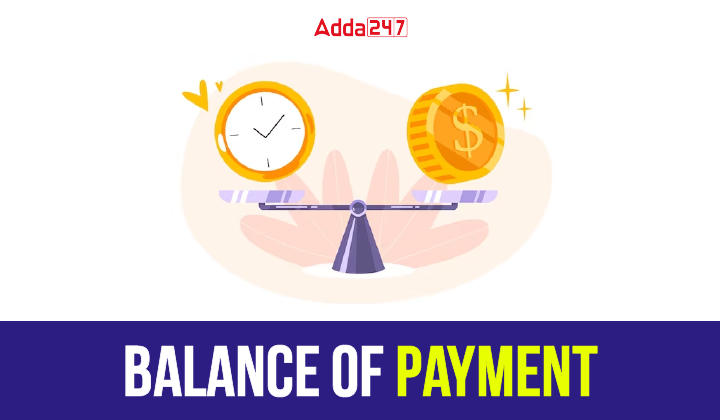Table of Contents
The world has become a global village. Countries are dependent on each other for trade and perform several transactions. Hence, it becomes important for the nations to keep a record of these foreign transactions. This record kept by the countries is called the Balance of Payments (BoP). In this article, we will learn the meaning of balance of payment, its features, its difference from balance of trade and forms of balance of payment.
Balance of Payment Overview
Nowadays, the role of foreign trade has increased manifold. At present, no country can remain isolated from the rest of the world. Every country is exporting/importing goods, and services and making different capital transactions with other countries. In one transaction, a country may be receiving foreign exchange and in the other transaction, it may be paying the same. To know the net position, a systematic record of these monetary transactions is made. This systematic record is known as the Balance of Payments
Meaning of Balance of Payments
Balance of Payments refers to the recording of all economic transactions of a given country with the rest of the world. Each country has to enter into economic transactions with other countries of the world. As a result of such transactions, it receives payments from and makes payments to other countries. Balance of payments is a statement of accounts of these receipts and payments
According to Kindle Berger, “The balance of Payments of a country is a systematic all economic transactions between its residents and residents of foreign countries”
According to Benham, “Balance of Payments of a country is a record of the monetary record of transactions over a period of time with the rest of the world.”
Features of Balance of Payment
Features of the Balance of Payments are mentioned in detail in the following section. Learn about these elements to understand the salient features which are essential to understanding the basics of Balance of Payment.
- Systematic Record: It is a systematic record of receipts and payments of a country with other countries.
- Fixed Period of Time: It is a statement of account pertaining to a given period of time, usually, one year.
- Comprehensive: It includes all three items, ie, visible, invisible and capital transfers.
- Double Entry System: Receipts and payments are recorded on the basis of the double entry system.
- Adjustment of Differences: Whenever there is a difference in actual total receipts and payments need for necessary adjustment is felt. In case of an unfavourable Balance of Payments, the government will have to take foreign loans or promote foreign investment, so as to meet the difference in the balance of payments.
- All items are included whether Government or Non-government: Balance of payments includes receipts and payments of all items both government and non-government.
Balance Of Trade
In the words of Benham, “Balance of trade of a country is the relation over a period between the values of its exports and imports of physical goods. A proper record of all material goods exported and imported is kept. With the help of this record of visible exports and imports, the balance of trade is computed.
Difference between Balance of Trade and Balance of Payment
The differences between the Balance of Trade (BOT) and Balance of Payment(BOP) are mentioned in the following table. Read the table for clarity of the Difference between Balance of Trade and Balance of Payment.
| Difference between Balance of Trade and Balance of Payment | ||
| Aspect | Balance of Trade (BOT) | Balance of Payments (BOP) |
| Definition | The difference between the value of exports and imports of physical goods (visible trade). | A comprehensive record of all economic transactions between a country and the rest of the world. It includes trade in goods and services, financial flows, and transfers. |
| Components | Include only visible trade (goods trade). | Includes trade in goods, trade in services, income receipts and payments, and unilateral transfers. |
| Goods vs Services | Focuses only on the trade of physical goods. | Encompasses both goods and services traded internationally. |
| Scope | Narrower scope, as it only considers the exchange of physical goods. | Broader scope, as it accounts for all economic transactions with other countries. |
| Impact on Currency | A surplus in the balance of trade (more exports than imports) can lead to currency appreciation. | The overall balance of payments affects a country’s foreign exchange reserves and can influence currency value. |
| Account Balance | Can have a positive, negative, or balanced trade balance. | Can have a surplus, deficit, or balanced overall balance of payments. |
| Influence on the Economy | A sustained trade deficit may affect a country’s production and employment patterns. | A deficit in the overall balance of payments might lead to borrowing or using foreign reserves to cover the gap. |
Forms of Balance of Payments
Balance of payments has three forms; namely: Current Account, Capital Account, and Overall Balance of Payments.
Current Account
The Balance of Payments on a current account includes the value of imports and exports of both visible (goods) and invisible items (services). Current account transactions are called accounts of actual transactions of import and export of goods and services. These items have a direct effect on the income, output and employment of a country’s economy.
Balance of Payments on Current Account = (Visible + Invisible Exports) – (Visible + Invisible Imports)
The balance of payments on current accounts may be both balanced and unbalanced. In the Balanced position of BoP, receipts and payments on account of exports and imports are equal. In case of an unbalanced balance of payments, it can be in deficit or in surplus. Disequilibrium of the balance of payments on the current account is usually balanced with the help of transactions in capital accounts.
Capital Account
Capital account refers to financial transactions. It mainly includes foreign investment and external loans. All kinds of short-term and long-term international capital transfers, foreign debts, foreign investments, payments and receipts on account of interest and grants, etc. are also included in the capital account. All transactions under a capital account are concerned merely with financial transfers, between our country and other foreign countries.
Overall Balance of Payments
The total of a country’s balance of payments on the current account and the capital account is known as the overall balance of payments
In the narrow sense, the balance of payments means the balance of payments on the current account. A favourable or unfavourable balance of payments refers to a favourable or unfavourable balance of payments on a current account. An unfavourable balance of payments means that the total value of imports of visible as well as invisible items is greater than the total value of exports of visible as well as invisible items. A favourable balance of payments means that India’s foreign trade is profitable, and visible and invisible exports are greater than visible and invisible imports.
In a broader sense, the Balance of Payments refers to the Balance of Payments on the current account and capital account.
Balance of Payments = (Exports of Goods + Export of Services + Capital Receipts)-(Imports of Goods + Import of Services + Capital payments).
Structure of Balance of Payments
Balance of payment is a complete record of total receipts and payments of a country in relation to other countries over a given period of time. Total receipts constitute credit items and total payments constitute debit items of BOP. The structure of the balance of payments has, therefore: the Credit side and the Debit side.
The credit side includes values received or likely to be received from abroad. The debit side includes values paid or payable to other countries. The credit and debit items of the balance of payments are linked below:
| Balance of Payments | |
| Receipts (Credit) | Payments (Debit) |
| Items of Current Account | |
| Export of goods | Import of goods |
Export of Services
|
Import of services
|
| Gifts and donations received from foreign countries. | Gifts and donations to foreigners. |
| Items of Capital Account | |
| Receipts (Credit) | Payments (Debit) |
| Foreign private loans | Repayment of private loans taken from foreigners. |
| Inflow of banking capital due to foreign transactions | Outflow of banking capital due to foreign transactions |
| Loans received by the government | Repayment of loans by government sector |
| Decrease in Official Reserves | Increase in Official Reserves |
| International sale of gold | Purchase of gold international market |
| Other Capital Receipts | Other Capital Payments |
Conclusion
Maintaining a sustainable balance of payments is essential for long-term economic stability. The balance of payments serves as a crucial indicator of a country’s economic health and its interactions with the rest of the world. It reflects the intricate web of international trade, investment, and financial flows that shape a nation’s economic landscape.
Download UGC NET Commerce Study Notes PDF
The direct Link to Download UGC NET Commerce Study Notes PDF has been mentioned below. Candidate can download Balance of Payment Study Notes PDF which has been mentioned below.




 UGC NET Commerce Syllabus 2025 PDF Downl...
UGC NET Commerce Syllabus 2025 PDF Downl...
 UGC NET Teaching Aptitude Questions Answ...
UGC NET Teaching Aptitude Questions Answ...
 UGC NET Philosophy Syllabus 2025 PDF Dow...
UGC NET Philosophy Syllabus 2025 PDF Dow...




